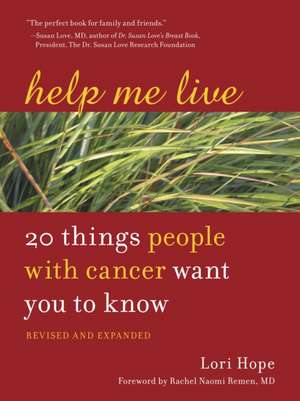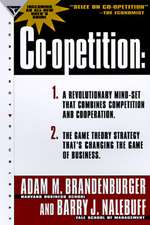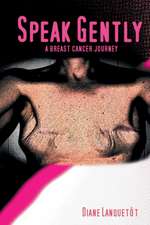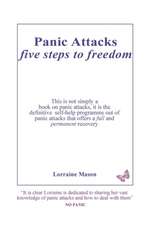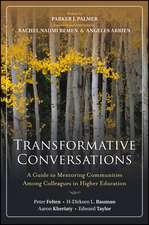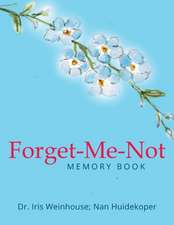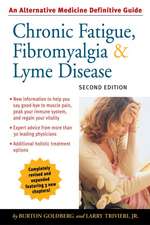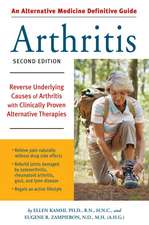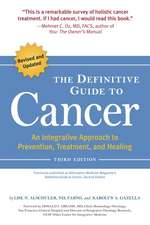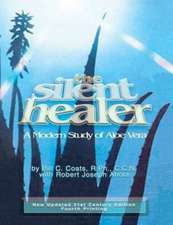Help Me Live: 20 Things People with Cancer Want You to Know
Autor Lori Hope Rachel Naomi Remenen Limba Engleză Paperback – 31 aug 2011
And, of course, we want nothing more than to offer comfort and support, and foster hope. But we don’t always know how—and may feel uncomfortable asking. Following her own treatment for cancer, Lori Hope created a survey for cancer survivors addressing issues they wanted their families, friends, and caregivers to understand. The results of the newly expanded survey are presented with honesty, insight, and humor, and complemented by scores of compelling personal stories from survivors of diverse ages and backgrounds.
If you are a caregiver, Help Me Live will help you communicate more effectively and respond more compassionately. And if you are a survivor, it will help you feel validated, empowered, and, ultimately, hopeful.
Preț: 115.20 lei
Nou
Puncte Express: 173
Preț estimativ în valută:
22.05€ • 23.96$ • 18.53£
22.05€ • 23.96$ • 18.53£
Carte disponibilă
Livrare economică 31 martie-14 aprilie
Preluare comenzi: 021 569.72.76
Specificații
ISBN-13: 9781587611490
ISBN-10: 158761149X
Pagini: 276
Ilustrații: ONE COLOR
Dimensiuni: 150 x 212 x 20 mm
Greutate: 0.31 kg
Ediția:Revised, Expand
Editura: CELESTIAL ARTS
ISBN-10: 158761149X
Pagini: 276
Ilustrații: ONE COLOR
Dimensiuni: 150 x 212 x 20 mm
Greutate: 0.31 kg
Ediția:Revised, Expand
Editura: CELESTIAL ARTS
Notă biografică
Lori Hope is a journalist, Emmy-winning documentary filmmaker, and speaker. A tireless advocate for those struggling with the social and interpersonal challenges that come with cancer, she has served on the board of the Bonnie J. Addario Lung Cancer Foundation, has volunteered for The Lung Cancer Alliance and the National Lung Cancer Partnership, and has spoken before the American Cancer Society, the Oncology Nursing Society, and Tulane Medical School. Her commitment to cancer survivors will continue until this book is no longer needed. Visit www.lorihope.com.
Extras
introduction
What do we live for, if it is not to make life less difficult for each other? —George Eliot
I AWAKEN IN MY DORMITORY-SIZE room and can hardly wait to peek outside at the young, thin-limbed maple tree silhouetted against the 6 a.m. lilac-gray sky. What a thrill to be on my own, poised to finish the final chapter of this book, a book about cancer. No, a book about hope—about listening—about being there.
On a private writing retreat at a wooded monastery in northwest Washington, named for St. Placid, a monk rescued from drowning by a fellow monk, I feel happier than I can remember. Having survived cancer, I just returned from Cancer as a Turning Point, a free conference that freshened my heart with hope. My nineteen-year-old son, Brett, recently called my cell phone to ask if I know anyone who needs a newspaper subscription which he wants to purchase out of compassion for the salesman outside Safeway. And, finally, my husband left a voicemail saying with love rich as fudge, “I miss you so much.” It doesn’t get much better than this.
As I move through the hallway in my slippers, I step gingerly to avoid disturbing the other retreatants sleeping behind doors labeled for Benedictines such as Heloise and Hrotsvit of Gandersheim. In the fluorescent-lit communal kitchen that still smells of popcorn from the night before, I turn a stainless steel knob next to the faucet, pumping 190-degree water into a plastic cone to brew my go-juice, and leave the kitchen, quietly shutting the door behind me.
Laptop cradled tightly against my left ribs—ribs split apart two years ago so a lobe of my lung could be removed—I walk through the propped-open door labeled, “Parlor,” eight feet across the hall from Hadewijch, named for the Benedictine who coined “Love conquers all things.” I gently place my computer on the loveseat and bend to lift the brass doorstop. I close the door so I can rustle papers, tap the keyboard, and talk to myself without disturbing the man in Hadewijch, an egg-shaped man with silver eyebrows and plaid shirt, a Leprechaun-lumberjack hybrid who told me the night before that he recently lost his wife of fifty years. Five decades. Can you imagine?
Safe in the well-insulated parlor, my fingers type with impunity. Deep in thought, calm and focused, a loud KAPLUNK! shoots my pulse from 60 to 100. The door, which I had closed so gently, had apparently not closed completely. Natural law had asserted its rule to complete the action.
If it had been able to speak, this is what the heavy hunk of wood might have declared: “The road to hell is paved with the best intentions. Due to circumstances both within and beyond your control, you have and may continue to unintentionally disturb people you wish to avoid hurting at all cost.”
I relax into a quiet laugh and ask myself, “So what is the point of writing a book about supporting people with cancer, since you will likely hurt them anyway—since they may hear words differently than you intended them, or attach a different or distorted meaning to your actions?”
The Point
In deciding how to act or what to say to the ill, infirm, or suffering, we rely on advice or examples presented by role models from childhood on. Real-life people and events, fairy tales and stories, entertainment, and popular and news media show us what works and fails, teaching right from wrong. The problem is, we do not live in a world of immutable right and wrong, black and white; rather, we make our way through a spectral universe broader and richer than most of us have the capacity, imagination, or patience to visualize. Age, diagnosis, prognosis, gender, and cultural background help determine reactions. What comforts one may crush another. Each person’s psyche is as unique as her fingerprints.
In addition, people differ not only from one another, but within themselves, depending on the day—especially days made significant by doctors’ appointments, anniversaries or special occasions—or even time of day. Plus, cancer survivors may change drastically over time, through phases of diagnosis, treatment, and beyond.
Finally, in this death-and-illness-phobic, youth-and-beauty-adoring culture, many of us live far from our aged kin and see them rarely, compared to earlier times when we lived with and cared for our elders, so we don’t have the daily role models that our ancestors did. We don’t have the opportunity to learn how to be care providers.
So what’s the point? The point is to inspire you to imagine; to illustrate what may help or hurt; to provide a range of possibilities and contexts so that after considering your audience and taking focused time to think, you can determine what’s most beneficial to the person you want more than anything to support. The purpose is not to dictate right and wrong, because what soothes one may scrape or stab another. The purpose is to provide general guidelines and principles of compassionate communication; to help you realize that what comes out of your mouth is born in your history, and you can keep it there if you want. As the grandmother of etiquette, Emily Post, wrote almost a century ago, “Think before you speak—nearly all the faults or mistakes in conversation are caused by not thinking.”
Think about these questions before you speak: Do you want to ask someone with lung cancer whether they smoke because you smoked and fear you could get cancer? Are you compelled to tell someone with cancer that you know someone else with cancer who just died, because you’re shocked and don’t know what else to say, or feel uncomfortable touching her hand and saying something simple like, “It’s not fair”? Do you feel a blurt coming fast as a fart because you cannot stay in your own fear?
And before you act, or neglect to act, ask yourself this: do you conveniently become too busy to call or visit because you fear facing a tragedy that could befall you or someone you love?
If you ask yourself those questions, you will surely find the words and actions to show how much you care.
Why don’t people with cancer just tell us what helps and hurts?
Why should we have to guess what others want and need from us? Why don’t they just assert themselves if we blurt something that upsets them, and ask us to zip it? If they don’t want our advice, why don’t they just say so?
Many people, whether they have cancer or not, fear hurting the offender, whom they assume meant no harm. Therapist and two-time breast cancer survivor Halina Irving, who has worked with survivors for decades, says cancer patients not only fear hurting others, they lack emotional strength because they are traumatized.
“All this talk today about patients needing to be proactive, well that’s well and good, but to ask someone to be proactive at a time they are least able to be aggressive and assertive is very, very difficult because we regress more to a state of dependency.”
And in that state of dependency, we often fear that if we confront the offender, they may leave us forever.
Why not just follow the Golden Rule?
On another writing retreat, I found a puzzle of Norman Rockwell’s famed painting The Golden Rule, which appeared on a 1961 Saturday Evening Post cover. It shows some twenty people of different ethnicities, ages, and religions standing together; some with pressed palms in prayer, others holding native tools or sacred objects. Superimposed over the painting, in all capital letters, are the words “Do Unto Others as You Would Have Them Do Unto You.”
Once I began assembling the pieces, I could not stop. I yearned to make it fit together, to create order from chaos, to make meaning from bits of seemingly meaningless images. All the while, I admired the beautiful faces—brown and ochre, smooth and leathered—and contemplated the Golden Rule. Like a prayer, I got lost in the puzzle, finally completing it after midnight.
I awakened the next morning, turned over the puzzle box for the first time, and read about the illustration: “The Buddhists say, ‘Hurt not others with that which pains yourself.’ In the Jewish Talmud we find, ‘What is hurtful to yourself, do not to your fellow man.’ And in the Hindu Mahabharata, ‘Do naught to others which if done to thee would cause thee pain.’” And so on, through all the faiths.
A few days later, I interviewed Irving. “It’s seems so simple. Why don’t we just follow the Golden Rule when dealing with people with cancer?” I asked.
“We don’t always know what we would want under those circumstances,” said Irving. “I think this is the one experience you have to have lived to really know what you would do.”
Or, I would add, “what you would want.”
That’s why a chorus of voices as diverse as the faces in Rockwell’s illustration will sing a symphony of stories in multiple keys; hopefully, one or more will resonate with you.
What I hope you will get out of this book is not just answers, but also relief and reassurance. Putting yourself in your friend’s or loved one’s shoes will enable you to step back out, relieved perhaps to face your own familiar problems again. More important, the experience will leave you richer for having truly given of yourself—for having helped someone live. As an added bonus, helping someone else live may help you live as well. A recent study showed that people who showed more compassion exhibited lower blood pressure, heart rate, and levels of the stress hormone cortisol.
Once you have completed the book, you should find it easier to follow Ms. Post’s first, last, and only rule:
“Above all, stop and think what you are saying!”
And hopefully you will find the strength to say nothing at all, except with your arms, open to embrace a shocked or weakened body, or your eyes, open to acknowledge and hold someone’s anguish. Just the fact that you are reading this book tells me that you cannot help but find your way.
Throughout this book you will be a fly on the wall in the lives of people who share a class of disease, but who sport idiosyncratic and sometimes contradictory needs. Although individuals may differ in major ways, fundamentally people are people, and as the Help Me Live Survivor Survey indicates, most of us want the same things: to feel heard, respected, understood, and valued. Most of all, we need to feel loved. “I love you,” in fact, are the words survey respondents said they most want to hear.
If you remember just one idea from this book, I hope it will be to think about the person with cancer and what they may need, not what you need. It is not about saying what’s wise, intelligent, or compassionate. It is about saying what the patient wants to hear and what will buoy hope. He or she, not you, is facing the battle of a lifetime—sometimes the battle for life itself.
So when you are faced with the face of cancer, don’t look away. Watch. Listen. Think. Comfort. Love. That is what will help your friend or loved one live.
part I: 20 things people with cancer want you to know
1: “It’s okay to say or do the ‘wrong’ thing.”
I have brutalized more patients by responding lovingly and caringly in the wrong way.—Lawrence LeShan, PhD
WHEN MY FRIEND ALICE WAS about to undergo minor surgery and asked me to take her to the hospital the morning of the procedure, I agreed without hesitation. She was there for me the day I was diagnosed with cancer—her birthday, in fact, which I had forgotten and she did not mention—and throughout my lost-in-space trip through the Cancersphere. She helped create a luscious garden of chocolate mint, rosemary, and thyme in my front yard; brought gifts such as lavender bubble bath to soothe my sorrows; took me for a massage soon after my body healed from surgery but my spirit still ached with dank memories.
Alice explained why she wanted me, of all her girlfriends, to take her to surgery. “I know you can keep quiet—that you won’t be yakkin’ all the time!”
I awakened at 5 a.m. that June morning, worried and anxious. My cancer surgery almost exactly one year before had frightened me to my core, and Alice’s imminent operation took me back to the morning of mine. The thought of losing her was terrifying, and I couldn’t seem to shake it, but I knew not to share my trepidation with her. Resigned to a masquerade, I downed two cups of extra strong coffee and set off to face the day with a strong face.
When I reached Alice’s home at 7 a.m., I was still buzzing.
“Hey! How you doing?” I asked, eyebrows raised too high.
“I’m okay.” Always the polite hostess, Al proffered a cup of coffee.
I should have known better, but I thought gripping a cup might help me get a handle on my fear. Instead, I lost hold.
“I’m so glad I get to be with you this morning,” I chirped. “So, how you feeling? Did you see that story on the news last night about the new museum?”
Like a dog wanting to go out to pee, I shadowed Alice from kitchen to dining room to living room, continuing with, “What time do we need to get out of here?” “How long will it take to get to the hospital?” “Should I park in the garage or on the street?”
“Shhhhhhhhhhhhhhhh,” Alice breathed out slowly “I need calm. I need quiet,” she whispered.
I couldn’t believe what I had done, knowing what a person going into surgery needs! And Alice had even asked for what she needed.
Why we blunder
I blundered that morning because, wrapped in my own understandable fear and anxiety, and moving posthaste, fueled by caffeine and a desire to get on with and beyond the surgery, I lacked the consciousness to train my focus on Alice. I was simply not there.
Sometimes we blurt because we feel uncomfortable and gravitate toward tried and true platitudes that are untrue more often than not, but which anchor us in an idealized reality (see chapter 16). Another reason we slip is that in our silence, we feel awkward and think we should gift someone with wise, helpful words. But in fact, as we will see later, and as Rachel Naomi Remen, MD, one of the earliest pioneers in the mind/body holistic health movement and cofounder of the Commonweal Cancer Help Program wrote in Kitchen Table Wisdom: Stories That Heal, “Perhaps the most important thing we ever give each other is our attention. . . . A loving silence often has far more power to heal and to connect than the most well-intentioned words.”
We may also feel plagued by guilt or shame at the secret relief we feel at having thus far escaped this fate ourselves. Comparative religion scholar Karen Armstrong says it is important we acknowledge and accept that everyone has a dark side, so we can have compassion for others and ourselves. We may also harbor the belief that somehow our friends’ suffering is deserved or earned, as Rabbi Harold Kushner explores in his evergreen book, When Bad Things Happen to Good People. Instead of accepting these normal and understandable reactions, we may experience punishing anxiety and confusion, causing us again to focus more on ourselves than the person we want more than anything to help.
In any event, no matter why we may err, it’s imperative we realize that such errors are not only fully understandable but also wholly forgivable.
What do we live for, if it is not to make life less difficult for each other? —George Eliot
I AWAKEN IN MY DORMITORY-SIZE room and can hardly wait to peek outside at the young, thin-limbed maple tree silhouetted against the 6 a.m. lilac-gray sky. What a thrill to be on my own, poised to finish the final chapter of this book, a book about cancer. No, a book about hope—about listening—about being there.
On a private writing retreat at a wooded monastery in northwest Washington, named for St. Placid, a monk rescued from drowning by a fellow monk, I feel happier than I can remember. Having survived cancer, I just returned from Cancer as a Turning Point, a free conference that freshened my heart with hope. My nineteen-year-old son, Brett, recently called my cell phone to ask if I know anyone who needs a newspaper subscription which he wants to purchase out of compassion for the salesman outside Safeway. And, finally, my husband left a voicemail saying with love rich as fudge, “I miss you so much.” It doesn’t get much better than this.
As I move through the hallway in my slippers, I step gingerly to avoid disturbing the other retreatants sleeping behind doors labeled for Benedictines such as Heloise and Hrotsvit of Gandersheim. In the fluorescent-lit communal kitchen that still smells of popcorn from the night before, I turn a stainless steel knob next to the faucet, pumping 190-degree water into a plastic cone to brew my go-juice, and leave the kitchen, quietly shutting the door behind me.
Laptop cradled tightly against my left ribs—ribs split apart two years ago so a lobe of my lung could be removed—I walk through the propped-open door labeled, “Parlor,” eight feet across the hall from Hadewijch, named for the Benedictine who coined “Love conquers all things.” I gently place my computer on the loveseat and bend to lift the brass doorstop. I close the door so I can rustle papers, tap the keyboard, and talk to myself without disturbing the man in Hadewijch, an egg-shaped man with silver eyebrows and plaid shirt, a Leprechaun-lumberjack hybrid who told me the night before that he recently lost his wife of fifty years. Five decades. Can you imagine?
Safe in the well-insulated parlor, my fingers type with impunity. Deep in thought, calm and focused, a loud KAPLUNK! shoots my pulse from 60 to 100. The door, which I had closed so gently, had apparently not closed completely. Natural law had asserted its rule to complete the action.
If it had been able to speak, this is what the heavy hunk of wood might have declared: “The road to hell is paved with the best intentions. Due to circumstances both within and beyond your control, you have and may continue to unintentionally disturb people you wish to avoid hurting at all cost.”
I relax into a quiet laugh and ask myself, “So what is the point of writing a book about supporting people with cancer, since you will likely hurt them anyway—since they may hear words differently than you intended them, or attach a different or distorted meaning to your actions?”
The Point
In deciding how to act or what to say to the ill, infirm, or suffering, we rely on advice or examples presented by role models from childhood on. Real-life people and events, fairy tales and stories, entertainment, and popular and news media show us what works and fails, teaching right from wrong. The problem is, we do not live in a world of immutable right and wrong, black and white; rather, we make our way through a spectral universe broader and richer than most of us have the capacity, imagination, or patience to visualize. Age, diagnosis, prognosis, gender, and cultural background help determine reactions. What comforts one may crush another. Each person’s psyche is as unique as her fingerprints.
In addition, people differ not only from one another, but within themselves, depending on the day—especially days made significant by doctors’ appointments, anniversaries or special occasions—or even time of day. Plus, cancer survivors may change drastically over time, through phases of diagnosis, treatment, and beyond.
Finally, in this death-and-illness-phobic, youth-and-beauty-adoring culture, many of us live far from our aged kin and see them rarely, compared to earlier times when we lived with and cared for our elders, so we don’t have the daily role models that our ancestors did. We don’t have the opportunity to learn how to be care providers.
So what’s the point? The point is to inspire you to imagine; to illustrate what may help or hurt; to provide a range of possibilities and contexts so that after considering your audience and taking focused time to think, you can determine what’s most beneficial to the person you want more than anything to support. The purpose is not to dictate right and wrong, because what soothes one may scrape or stab another. The purpose is to provide general guidelines and principles of compassionate communication; to help you realize that what comes out of your mouth is born in your history, and you can keep it there if you want. As the grandmother of etiquette, Emily Post, wrote almost a century ago, “Think before you speak—nearly all the faults or mistakes in conversation are caused by not thinking.”
Think about these questions before you speak: Do you want to ask someone with lung cancer whether they smoke because you smoked and fear you could get cancer? Are you compelled to tell someone with cancer that you know someone else with cancer who just died, because you’re shocked and don’t know what else to say, or feel uncomfortable touching her hand and saying something simple like, “It’s not fair”? Do you feel a blurt coming fast as a fart because you cannot stay in your own fear?
And before you act, or neglect to act, ask yourself this: do you conveniently become too busy to call or visit because you fear facing a tragedy that could befall you or someone you love?
If you ask yourself those questions, you will surely find the words and actions to show how much you care.
Why don’t people with cancer just tell us what helps and hurts?
Why should we have to guess what others want and need from us? Why don’t they just assert themselves if we blurt something that upsets them, and ask us to zip it? If they don’t want our advice, why don’t they just say so?
Many people, whether they have cancer or not, fear hurting the offender, whom they assume meant no harm. Therapist and two-time breast cancer survivor Halina Irving, who has worked with survivors for decades, says cancer patients not only fear hurting others, they lack emotional strength because they are traumatized.
“All this talk today about patients needing to be proactive, well that’s well and good, but to ask someone to be proactive at a time they are least able to be aggressive and assertive is very, very difficult because we regress more to a state of dependency.”
And in that state of dependency, we often fear that if we confront the offender, they may leave us forever.
Why not just follow the Golden Rule?
On another writing retreat, I found a puzzle of Norman Rockwell’s famed painting The Golden Rule, which appeared on a 1961 Saturday Evening Post cover. It shows some twenty people of different ethnicities, ages, and religions standing together; some with pressed palms in prayer, others holding native tools or sacred objects. Superimposed over the painting, in all capital letters, are the words “Do Unto Others as You Would Have Them Do Unto You.”
Once I began assembling the pieces, I could not stop. I yearned to make it fit together, to create order from chaos, to make meaning from bits of seemingly meaningless images. All the while, I admired the beautiful faces—brown and ochre, smooth and leathered—and contemplated the Golden Rule. Like a prayer, I got lost in the puzzle, finally completing it after midnight.
I awakened the next morning, turned over the puzzle box for the first time, and read about the illustration: “The Buddhists say, ‘Hurt not others with that which pains yourself.’ In the Jewish Talmud we find, ‘What is hurtful to yourself, do not to your fellow man.’ And in the Hindu Mahabharata, ‘Do naught to others which if done to thee would cause thee pain.’” And so on, through all the faiths.
A few days later, I interviewed Irving. “It’s seems so simple. Why don’t we just follow the Golden Rule when dealing with people with cancer?” I asked.
“We don’t always know what we would want under those circumstances,” said Irving. “I think this is the one experience you have to have lived to really know what you would do.”
Or, I would add, “what you would want.”
That’s why a chorus of voices as diverse as the faces in Rockwell’s illustration will sing a symphony of stories in multiple keys; hopefully, one or more will resonate with you.
What I hope you will get out of this book is not just answers, but also relief and reassurance. Putting yourself in your friend’s or loved one’s shoes will enable you to step back out, relieved perhaps to face your own familiar problems again. More important, the experience will leave you richer for having truly given of yourself—for having helped someone live. As an added bonus, helping someone else live may help you live as well. A recent study showed that people who showed more compassion exhibited lower blood pressure, heart rate, and levels of the stress hormone cortisol.
Once you have completed the book, you should find it easier to follow Ms. Post’s first, last, and only rule:
“Above all, stop and think what you are saying!”
And hopefully you will find the strength to say nothing at all, except with your arms, open to embrace a shocked or weakened body, or your eyes, open to acknowledge and hold someone’s anguish. Just the fact that you are reading this book tells me that you cannot help but find your way.
Throughout this book you will be a fly on the wall in the lives of people who share a class of disease, but who sport idiosyncratic and sometimes contradictory needs. Although individuals may differ in major ways, fundamentally people are people, and as the Help Me Live Survivor Survey indicates, most of us want the same things: to feel heard, respected, understood, and valued. Most of all, we need to feel loved. “I love you,” in fact, are the words survey respondents said they most want to hear.
If you remember just one idea from this book, I hope it will be to think about the person with cancer and what they may need, not what you need. It is not about saying what’s wise, intelligent, or compassionate. It is about saying what the patient wants to hear and what will buoy hope. He or she, not you, is facing the battle of a lifetime—sometimes the battle for life itself.
So when you are faced with the face of cancer, don’t look away. Watch. Listen. Think. Comfort. Love. That is what will help your friend or loved one live.
part I: 20 things people with cancer want you to know
1: “It’s okay to say or do the ‘wrong’ thing.”
I have brutalized more patients by responding lovingly and caringly in the wrong way.—Lawrence LeShan, PhD
WHEN MY FRIEND ALICE WAS about to undergo minor surgery and asked me to take her to the hospital the morning of the procedure, I agreed without hesitation. She was there for me the day I was diagnosed with cancer—her birthday, in fact, which I had forgotten and she did not mention—and throughout my lost-in-space trip through the Cancersphere. She helped create a luscious garden of chocolate mint, rosemary, and thyme in my front yard; brought gifts such as lavender bubble bath to soothe my sorrows; took me for a massage soon after my body healed from surgery but my spirit still ached with dank memories.
Alice explained why she wanted me, of all her girlfriends, to take her to surgery. “I know you can keep quiet—that you won’t be yakkin’ all the time!”
I awakened at 5 a.m. that June morning, worried and anxious. My cancer surgery almost exactly one year before had frightened me to my core, and Alice’s imminent operation took me back to the morning of mine. The thought of losing her was terrifying, and I couldn’t seem to shake it, but I knew not to share my trepidation with her. Resigned to a masquerade, I downed two cups of extra strong coffee and set off to face the day with a strong face.
When I reached Alice’s home at 7 a.m., I was still buzzing.
“Hey! How you doing?” I asked, eyebrows raised too high.
“I’m okay.” Always the polite hostess, Al proffered a cup of coffee.
I should have known better, but I thought gripping a cup might help me get a handle on my fear. Instead, I lost hold.
“I’m so glad I get to be with you this morning,” I chirped. “So, how you feeling? Did you see that story on the news last night about the new museum?”
Like a dog wanting to go out to pee, I shadowed Alice from kitchen to dining room to living room, continuing with, “What time do we need to get out of here?” “How long will it take to get to the hospital?” “Should I park in the garage or on the street?”
“Shhhhhhhhhhhhhhhh,” Alice breathed out slowly “I need calm. I need quiet,” she whispered.
I couldn’t believe what I had done, knowing what a person going into surgery needs! And Alice had even asked for what she needed.
Why we blunder
I blundered that morning because, wrapped in my own understandable fear and anxiety, and moving posthaste, fueled by caffeine and a desire to get on with and beyond the surgery, I lacked the consciousness to train my focus on Alice. I was simply not there.
Sometimes we blurt because we feel uncomfortable and gravitate toward tried and true platitudes that are untrue more often than not, but which anchor us in an idealized reality (see chapter 16). Another reason we slip is that in our silence, we feel awkward and think we should gift someone with wise, helpful words. But in fact, as we will see later, and as Rachel Naomi Remen, MD, one of the earliest pioneers in the mind/body holistic health movement and cofounder of the Commonweal Cancer Help Program wrote in Kitchen Table Wisdom: Stories That Heal, “Perhaps the most important thing we ever give each other is our attention. . . . A loving silence often has far more power to heal and to connect than the most well-intentioned words.”
We may also feel plagued by guilt or shame at the secret relief we feel at having thus far escaped this fate ourselves. Comparative religion scholar Karen Armstrong says it is important we acknowledge and accept that everyone has a dark side, so we can have compassion for others and ourselves. We may also harbor the belief that somehow our friends’ suffering is deserved or earned, as Rabbi Harold Kushner explores in his evergreen book, When Bad Things Happen to Good People. Instead of accepting these normal and understandable reactions, we may experience punishing anxiety and confusion, causing us again to focus more on ourselves than the person we want more than anything to help.
In any event, no matter why we may err, it’s imperative we realize that such errors are not only fully understandable but also wholly forgivable.
Recenzii
“The perfect book for family and friends.”
—Susan Love, MD, author of Dr. Susan Love’s Breast Book, President, The Dr. Susan Love Research Foundation
“This book is a gift to anyone who has been touched by cancer.”
—Nancy L. Snyderman, M.D., F.A.C.S., NBC News Chief Medical Editor, Associate Professor Head and Neck Surgery, University of Pennsylvania
“Lori Hope writes with an eloquence and authenticity that inspires all her readers. If you or a loved one have been touched by cancer, Help Me Live is required reading.”
—Greg Anderson, author of Cancer: 50 Essential Things to Do, Founder and CEO, Cancer Recovery Foundation Group
“Lori Hope offers guidance that is always sensitive and often deeply illuminating. Please, please, read this book!”
—Barbara Ehrenreich, author of Bright–Sided: How Positive Thinking Is Undermining America and Nickel and Dimed
“This is a book every cancer survivor, as well as those who share our world, need to read. She says the words that none of us wants to say out loud and offers realistic explanations of how we all need to relate to our disease. This book can offer a great deal of comfort to those starting on the path of living with cancer.”
—Kathryn Joosten, actress, The West Wing, Desperate Housewives, and Scrubs
“In Help Me Live, Lori Hope has created a masterpiece of compelling and heartfelt words of heal-
ing that should be required reading for doctors, family, and friends of anyone traversing the cancer landscape.”
—Regina Vidaver, PhD, Executive Director, The National Lung Cancer Partnership
“Even though I am a twenty-year survivor, I needed to be reminded about what people in the throes of cancer need, and Lori Hope’s book is perfect.”
—Kathy La Tour, Editor-at-Large, Cure magazine
“In working over fifteen years as an oncology social worker, it seemed as if Lori Hope had been sitting alongside me catching the rich insights and poignant narratives of our clients and then beautifully crafted Help Me Live to assist the world in truly understanding how one best helps the cancer patient.”
—Win Boerckel, LCSW, MSW, Director of Social Service, CancerCare of Long Island
“Lori Hope’s masterful storytelling and clear explanations are invaluable.”
—Wendy Harpham, MD, author of Happiness in a Storm, Diagnosis: Cancer, and Only 10 Seconds to Care: Help and Hope for Busy Clinicians
“Always compassionate and pragmatic, Help Me Live breaks new ground with sections on children and young adults and cultural considerations—truly a wonderful resource for all of us.”
—Peggy McGuire, Executive Director, Women’s Cancer Resource Center
“Help Me Live is beautifully written and offers extraordinary pearls of wisdom on love, on hope, on survivorship, on friendship.”
—Laurie Fenton Ambrose, President and CEO, Lung Cancer Alliance
“As a two-time survivor of breast cancer and a journalist, I found Help Me Live to be informative, touching, and even funny—and when it comes to cancer, you need a sense of humor. The author certainly lives up to her name.”
—Laura Marquez, ABC News correspondent
“[Hope] writes exquisitely of the emotions and the roller-coaster ride of a cancer diagnosis and treatment. As a nurse educator, I plan to share this book with my students to try and give them some insight into the common experiences that many cancer patients have, as well as the uncommon ones.”
—Patricia Reilly, California State University School of Nursing
“This book is invaluable for anyone diagnosed with cancer and for anyone who has a family member or friend battling the disease. Lori Hope, a lung cancer survivor, writes intimately, poignantly, poetically, and humorously.”
—Marc Silver, author of Breast Cancer Husband: Help Your Wife (and Yourself) during Diagnosis, Treatment, and Beyond
—Susan Love, MD, author of Dr. Susan Love’s Breast Book, President, The Dr. Susan Love Research Foundation
“This book is a gift to anyone who has been touched by cancer.”
—Nancy L. Snyderman, M.D., F.A.C.S., NBC News Chief Medical Editor, Associate Professor Head and Neck Surgery, University of Pennsylvania
“Lori Hope writes with an eloquence and authenticity that inspires all her readers. If you or a loved one have been touched by cancer, Help Me Live is required reading.”
—Greg Anderson, author of Cancer: 50 Essential Things to Do, Founder and CEO, Cancer Recovery Foundation Group
“Lori Hope offers guidance that is always sensitive and often deeply illuminating. Please, please, read this book!”
—Barbara Ehrenreich, author of Bright–Sided: How Positive Thinking Is Undermining America and Nickel and Dimed
“This is a book every cancer survivor, as well as those who share our world, need to read. She says the words that none of us wants to say out loud and offers realistic explanations of how we all need to relate to our disease. This book can offer a great deal of comfort to those starting on the path of living with cancer.”
—Kathryn Joosten, actress, The West Wing, Desperate Housewives, and Scrubs
“In Help Me Live, Lori Hope has created a masterpiece of compelling and heartfelt words of heal-
ing that should be required reading for doctors, family, and friends of anyone traversing the cancer landscape.”
—Regina Vidaver, PhD, Executive Director, The National Lung Cancer Partnership
“Even though I am a twenty-year survivor, I needed to be reminded about what people in the throes of cancer need, and Lori Hope’s book is perfect.”
—Kathy La Tour, Editor-at-Large, Cure magazine
“In working over fifteen years as an oncology social worker, it seemed as if Lori Hope had been sitting alongside me catching the rich insights and poignant narratives of our clients and then beautifully crafted Help Me Live to assist the world in truly understanding how one best helps the cancer patient.”
—Win Boerckel, LCSW, MSW, Director of Social Service, CancerCare of Long Island
“Lori Hope’s masterful storytelling and clear explanations are invaluable.”
—Wendy Harpham, MD, author of Happiness in a Storm, Diagnosis: Cancer, and Only 10 Seconds to Care: Help and Hope for Busy Clinicians
“Always compassionate and pragmatic, Help Me Live breaks new ground with sections on children and young adults and cultural considerations—truly a wonderful resource for all of us.”
—Peggy McGuire, Executive Director, Women’s Cancer Resource Center
“Help Me Live is beautifully written and offers extraordinary pearls of wisdom on love, on hope, on survivorship, on friendship.”
—Laurie Fenton Ambrose, President and CEO, Lung Cancer Alliance
“As a two-time survivor of breast cancer and a journalist, I found Help Me Live to be informative, touching, and even funny—and when it comes to cancer, you need a sense of humor. The author certainly lives up to her name.”
—Laura Marquez, ABC News correspondent
“[Hope] writes exquisitely of the emotions and the roller-coaster ride of a cancer diagnosis and treatment. As a nurse educator, I plan to share this book with my students to try and give them some insight into the common experiences that many cancer patients have, as well as the uncommon ones.”
—Patricia Reilly, California State University School of Nursing
“This book is invaluable for anyone diagnosed with cancer and for anyone who has a family member or friend battling the disease. Lori Hope, a lung cancer survivor, writes intimately, poignantly, poetically, and humorously.”
—Marc Silver, author of Breast Cancer Husband: Help Your Wife (and Yourself) during Diagnosis, Treatment, and Beyond
Cuprins
Foreword by Rachel Naomi Remen, MD — xi
Preface to the Revised Edition — 1
Introduction — 7
Part I: 20 Things People with Cancer Want You to Know
1. “It’s okay to say or do the ‘wrong’ thing.” — 15
2. “I need to know you’re here for me, but if you can’t be, you can still show you care.” — 23
3. “I like to hear success stories, not horror stories.” — 30
4. “I am terrified and need to know you’ll forgive me if I snap at you or bite your head off.” — 37
5. “I need you to listen to me and let me cry.” — 44
6. “Asking my permission can spare me pain.” — 55
7. “I need to laugh—or just forget about cancer for a while!” — 63
8. “I need to feel hope, but telling me to think positively can make me feel worse.” — 72
9. “I want you to respect my judgment and treatment decisions.” — 87
10.“I want you to give me an opening to talk about cancer, and then take my lead.” — 97
11. “I want compassion, not pity.” — 101
12. “Advice may not be what I need, and it can hurt more than help. Try comforting me instead.” — 108
13. “I am still me; treat me kindly, not differently.” — 115
14. “If you really want to help me, be specific about your offer, or just help without asking.” — 121
15. “I love being held in your thoughts or prayers.” — 127
16. “Hearing platitudes or what’s good about cancer can minimize my feelings.” — 133
17. “I don’t know why I got cancer, and hearing your theory may add grave insult to injury.” — 139
18. “Don’t take it personally if I don’t return your call or want to see you.” — 144
19. “I need you to offer support to my caregiver, because that helps me, too.” — 151
20. “I don’t know if I’m cured, and bringing up my health can bring me down.” — 159
And one more thing . . .
21. “I am more grateful than I can say for your care, compassion, and support.” — 165
Part II: A Quick Guide to Cancerquette
22. The 2010/2011 Survey — 171
23. Different Kinds of Cancer — 190
24. Cancer through the Stages — 195
25. Cancer in Different Circumstances — 204
26. Cancer at Different Ages — 209
27. She Wants/He Wants: Cancer and Gender — 225
28. Cancer and Cultural Background — 234
29. Other Situations, Complications, and Conditions — 239
30. The Lists: Do’s, Don’ts, Tools, and Treasures — 244
31. How to Listen — 256
32. The Cheat Sheet — 258
33. For Survivors: Hoping and Coping in a World of Uncertainty — 260
Afterword — 263
Acknowledgments — 267
Index — 269
Preface to the Revised Edition — 1
Introduction — 7
Part I: 20 Things People with Cancer Want You to Know
1. “It’s okay to say or do the ‘wrong’ thing.” — 15
2. “I need to know you’re here for me, but if you can’t be, you can still show you care.” — 23
3. “I like to hear success stories, not horror stories.” — 30
4. “I am terrified and need to know you’ll forgive me if I snap at you or bite your head off.” — 37
5. “I need you to listen to me and let me cry.” — 44
6. “Asking my permission can spare me pain.” — 55
7. “I need to laugh—or just forget about cancer for a while!” — 63
8. “I need to feel hope, but telling me to think positively can make me feel worse.” — 72
9. “I want you to respect my judgment and treatment decisions.” — 87
10.“I want you to give me an opening to talk about cancer, and then take my lead.” — 97
11. “I want compassion, not pity.” — 101
12. “Advice may not be what I need, and it can hurt more than help. Try comforting me instead.” — 108
13. “I am still me; treat me kindly, not differently.” — 115
14. “If you really want to help me, be specific about your offer, or just help without asking.” — 121
15. “I love being held in your thoughts or prayers.” — 127
16. “Hearing platitudes or what’s good about cancer can minimize my feelings.” — 133
17. “I don’t know why I got cancer, and hearing your theory may add grave insult to injury.” — 139
18. “Don’t take it personally if I don’t return your call or want to see you.” — 144
19. “I need you to offer support to my caregiver, because that helps me, too.” — 151
20. “I don’t know if I’m cured, and bringing up my health can bring me down.” — 159
And one more thing . . .
21. “I am more grateful than I can say for your care, compassion, and support.” — 165
Part II: A Quick Guide to Cancerquette
22. The 2010/2011 Survey — 171
23. Different Kinds of Cancer — 190
24. Cancer through the Stages — 195
25. Cancer in Different Circumstances — 204
26. Cancer at Different Ages — 209
27. She Wants/He Wants: Cancer and Gender — 225
28. Cancer and Cultural Background — 234
29. Other Situations, Complications, and Conditions — 239
30. The Lists: Do’s, Don’ts, Tools, and Treasures — 244
31. How to Listen — 256
32. The Cheat Sheet — 258
33. For Survivors: Hoping and Coping in a World of Uncertainty — 260
Afterword — 263
Acknowledgments — 267
Index — 269
